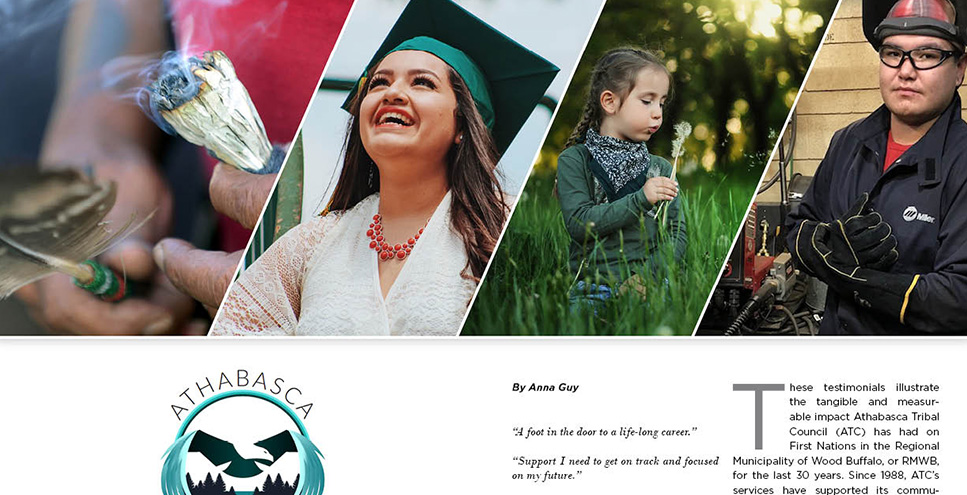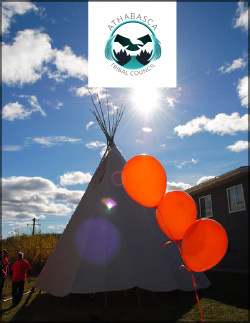By Anna Guy
“A foot in the door to a life-long career.”
“Support I need to get on track and focused on my future.”
“I am proud to be part of a community that encourages opportunities for growth.”
These testimonials illustrate the tangible and measurable impact Athabasca Tribal Council (ATC) has had on First Nations in the Regional Municipality of Wood Buffalo, or RMWB, for the last 30 years. Since 1988, ATC’s services have supported its community members to thrive—from services and programs for youth in pursuit of post secondary education, community members learning employment skills, to helping those in need access medical care.
Headquartered in Fort McMurray, with local Child & Family Services offices in Edmonton and Fort Chipewyan, ATC is made up of a Board of Directors, a CEO who oversees six active departments, specifically Education, Health, Finance, Employment and Training and Child and Family Services.
“We believe the goal and vision of ATC’s formation was a movement to decentralize government programming from Indigenous Services Canada, then Indian Affairs, and establish a council that could provide these services at the regional and community level,” says ATC CEO, Karla Buffalo.
Establishment of services being provided to community members, by a regional agency to amalgamate services, was a key consideration in the development of ATC, says Buffalo. “Having a Board of Directors assembled of the Chiefs of the Nations being served would mean that the needs of our communities would be brought to the forefront by community leaders,” she continues. “This meant listening to the needs of our people and acting directly on the information received in a culturally appropriate manner. Over time, the Tribal Council was able to take on additional services and provide more to communities as it has continued to develop.”
First Nations leadership in its communities are known throughout Alberta and the country as being well recognized for their accomplishments and consistency. ATC thrives because of a deep understanding of RMWB’s cultural diversity and needs. The RMWB is made up of both Cree and Dene cultures, as well as Metis. “Many of the challenges faced in the RMWB are similar to those of many First Nation Communities,” says Buffalo. “Remote locations, underfunding, limited access to culturally appropriate services, and communication gaps with respect to services that are available. We strive to bridge all of these gaps with the programs and services.”
Good Neighbours
In 2016, the Fort McMurry Fire devastated the RMWB area. ATC’s main office was one of two buildings left standing after the wildfire made its way down the Waterways subdivision of Fort McMurray, but still sustained significant damage. ATC, along with many of its neighbours and community friends, was displaced for nearly a year, after which the ATC took some time to reorganise. Not only did ATC members work along side its neighbours to help get the community back on its feet, ATC, in partnership with the Canadian Red Cross, recently concluded a comprehensive study along with a video and research launch to learn more about, and share information back to communities about the long-term impacts of the 2016 wildfire.
The project is the first Indigenous-controlled disaster study to bring together First Nations and Métis from an entire region. The project included 10 focus groups, 40 interviews, survey with more than 600 responses, and a video. The purpose of the study was to make sure that Indigenous impacts, concerns, and recommendations are heard by governments and to provide foundation for improved collaboration between Indigenous and non-Indigenous governments in disaster management.
Currently, Buffalo says her biggest priorities are “supporting our Nations as they continue to identify their needs and assist them with continuing to building their capacity to provide programs and services to their communities. We are focusing on building prevention based, culturally relevant and appropriate Child and Family Services programs for our Nations, as well as providing an increase in the quantity and quality of Health programming of our Nations. We are also working towards increasing funding for post secondary education. Through all of the work we do as an organization, supporting the revitalization of culture and language is at the forefront of our priorities.”
Bright Outlook
It’s an exciting time in ATC’s history. Presently, First Nations and Indigenous communities are growing their capacity as Individual Nations. ATC’s current focus is assisting Nations with becoming more self sufficient and developing programming to support their communities in ways that promote the self development of their membership.
“Currently, all of our Nations have excellent leaders within their communities supporting growth, development of the local economy, culture and language development and preservation,” says Buffalo. “This is exciting for both ATC staff and Nations.”
ATC staff are extremely passionate about the work they do and serving its communities. “I am nothing short of amazed by the work being done by ATC staff. We talk about resilience frequently in this organization and I am so very grateful to have a team that is exactly that,” says Buffalo. “Extremely resilient.”
30 successful years only motivates the ATC team to continue its progressive work. ATC is currently moving into a new phase of strategic planning, working to identify how it can further support our communities in a meaningful way in Child and Family Services, Education, Employment and Training, Technical Services and Health in the areas of prevention, culture, and language revitalization. Says Buffalo, “We will continue to strive to deliver services that add value to the lives our Nations communities and their members.”
For more information, or to see the ATC report, please click
www.atcfn.ca/research/







